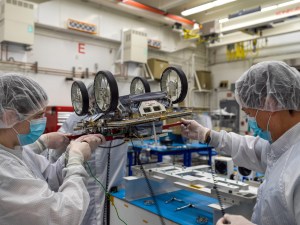NASA’s commitment to provide aeronautical research opportunities to U.S. universities has led to another success, this time through an inventive student who earned his Ph.D. by creating a tiny sensor that beats anything seen in 20 years.
Vijay Chandrasekharan is a research associate and doctoral candidate at the University of Florida, where he produced a micro-electronic sensor that measures the amount of shear stress created when turbulent air flows over a surface.
The sensor already has proven its usefulness in improving the basic understanding of turbulent flow in gases and liquids, and in characterizing wind tunnels.
When air flows through a wind tunnel, some air molecules stick to the wall of the tunnel while others flow through at the speed of the wind. The difference in speed exerts a drag force on the wall of the tunnel and causes friction in the air. Drag and friction are related to shear stress.
The new sensor can measure a wider range of shear stress than can any sensor of its type before.
Accurate measurements of shear stress are crucial to NASA’s and aircraft manufacturers’ research into developing more efficient airplanes. Shear stress affects the amount of drag on an aircraft. The more drag there is on an aircraft, the more fuel that aircraft burns.
Designers can use data from the sensors to design safer and more fuel-efficient aircraft.
There also are potential applications for this sensor in the fields of medical and environmental sciences. In medicine, for example, according to Chandrasekharan, the sensor could measure variations in shear stress along the wall of an artery and help researchers determine the effect those fluctuations have on the development of arteriosclerosis, commonly known as hardening of the arteries.
Chandrasekharan said the shear stress sensor is “one of the most successful efforts on direct shear stress sensors in published literature” and has a real shot at successfully entering the commercial market.
The sensor innovation is the result of a NASA Research Announcement, or NRA, study contract awarded by the Subsonic Fixed Wing Project of NASA’s Aeronautics Research Mission Directorate. The directorate awards dozens of contracts for NRA studies to academia each year. This three-year contract with the University of Florida was worth $475,000.
“This collaboration led to an extremely satisfying experience for me as I worked on my dissertation,” Chandrasekharan said. “Without NASA’s involvement my Ph.D. could have been strictly an academic pursuit, without subsequent practical, real-world importance.”
Experts outside NASA and the aeronautics community already have taken notice of the sensor, its potential, and its inventor. Chandrasekharan recently received one of 13 national postdoctoral entrepreneurial fellowships awarded by the Kauffman Foundation.
“The work done by Vijay and this NRA’s principal investigator, Mark Sheplak, is a great example of how NASA can work with a university to overcome fundamental challenges and lead to the improved safety and efficiency of our nation’s aircraft,” said Project Scientist Richard Wahls.
Chandrasekharan, Sheplak and two associates have filed a provisional patent application for the sensor.
Even as the original effort is lauded, a sequel to the story already is in work. As part of NASA’s Graduate Student Researchers Program one student is working to further develop the sensor’s electronic interface, while another is working on the wireless version of the sensor and recently performed tests with the sensor in a wind tunnel at NASA’s Langley Research Center in Hampton, Va.
“It’s good to see that our initial work has lead to synergistic outcomes at different levels through this NRA and other NASA programs,” Chandrasekharan said.


































